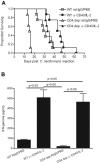Immunomodulation with CD40 stimulation and interleukin-2 protects mice from disseminated cryptococcosis
- PMID: 16552046
- PMCID: PMC1418893
- DOI: 10.1128/IAI.74.4.2161-2168.2006
Immunomodulation with CD40 stimulation and interleukin-2 protects mice from disseminated cryptococcosis
Abstract
Cryptococcus neoformans is a ubiquitous fungus that can cause life-threatening infections during immunosuppressive states such as AIDS and after bone marrow transplantation. In this study we investigated the antifungal efficacy of an agonist antibody to CD40, an important costimulator of immune function, in combination with interleukin 2 (IL-2) in a murine model of disseminated cryptococcosis. Only the combination of anti-CD40 and IL-2 significantly prolonged the survival time of infected mice. This protection was correlated with decreased yeast burdens in the brain and kidney. Increased immune cell populations in the spleens, as well as increased serum gamma interferon (IFN-gamma) and tumor necrosis factor alpha levels were observed in infected mice treated with anti-CD40 and IL-2. Further experiments with IFN-gamma knockout mice demonstrated that the protection induced by anti-CD40 and IL-2 treatment was dependent on IFN-gamma. Depletion of CD4+ T cells did not affect the increased serum IFN-gamma levels induced by anti-CD40 and IL-2 treatment and, importantly, did not affect the antifungal effect of combination therapy. These studies indicate that immunotherapy using anti-CD40 and IL-2 has therapeutic potential in augmenting host resistance to disseminated cryptococcosis and that IFN-gamma is essential for efficacy.
Figures







References
-
- Armitage, R. J., C. R. Maliszewski, M. R. Alderson, K. H. Grabstein, M. K. Spriggs, and W. C. Fanslow. 1993. CD40L: a multi-functional ligand. Semin. Immunol. 5:401-412. - PubMed
-
- Banchereau, J., F. Bazan, D. Blanchard, F. Briere, J. P. Galizzi, C. Van Kooten, Y. J. Liu, F. Rousset, and S. Saeland. 1994. The CD40 antigen and its ligand. Annu. Rev. Immunol. 12:881-922. - PubMed
Publication types
MeSH terms
Substances
Grants and funding
LinkOut - more resources
Full Text Sources
Molecular Biology Databases
Research Materials

